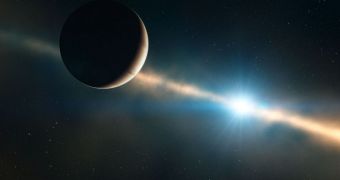Engineers constructing the successor to the NASA/ESA Hubble Space Telescope say that the James Webb Space Telescope (JWST) will also be able to detect exoplanets, in addition to being capable of seeing into the deepest corners of the Universe.
Since the US House of Representatives proposed cutting funds for the development of the telescope – motivating that the observatory may not return sufficient scientific data to justify the money needed to build it – astronomers have stepped forward to reveal exactly what the instrument can do.
The most important point experts are making is that JWST is not an upgraded Hubble. Rather than observing the Universe in visible-light and ultraviolet wavelengths, the new telescope will use infrared wavelengths to peer as far back in time as a few million years after the Big Bang.
The observatory will be deployed at the L2 Lagrangian point, which is located about 930,000 miles (1,500,000 kilometers) away from Earth, well beyond the orbit of the Moon. At this location, JWST will be protected from light emitted by the Sun, or reflected by the Earth and its Moon.
“JWST's complexity, with large deployable optics and other systems operating at 40 [degrees Kelvin] in an environment precluding any repair or servicing missions, has probably created one of the world's most complex and expensive integration and test programs,” Michael Kaplan explains
The expert was the first executive for the James Webb Space Telescope program. He explains that coasts soared from 2.4 billion dollars 5 years ago to about $8.7 billion by 2018, when the observatory is scheduled to launch.
Space Telescope Science Institute (STScI) director Matt Mountain and former NASA astronaut and STScI deputy director John Grunsfeld recently told Astrobiology Magazine editor Leslie Mullen in an interview that the JWST may be used to detect habitable extrasolar planets in the Milky Way.
The telescope will be able to observe exoplanets by deploying an autonomous shader spacecraft. That vehicle would move about 100,000 miles (161,000 kilometers) in front of the JWST, and block direct light from distant stars.
Shaded from the direct photon beams, the telescope's sensitive infrared detectors will be able to observe the glow of planets orbiting the obscured stars. This technique is very complex to apply, but theoretically allows for tremendous observation resolution, Space reports.

 14 DAY TRIAL //
14 DAY TRIAL //